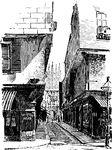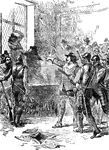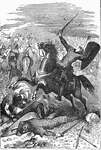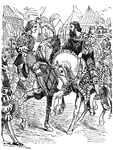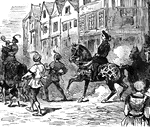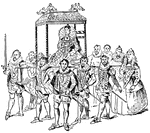Events in United Kingdom History
The Events in United Kingdom History ClipArt gallery offers 51 illustrations of famous events such as the death of Thomas a Becket, the Great Fire of London, and the signing of the Magna Carta.

Alfred In The Herdsman's Hut
Alfred hid in the Somersetshire marsh country and was thought to be a poor individual. The herdsman's…

The Siege of Alicant
The Siege of Alicant, Spain in 1709. Caption bellow illustration: "The mine at last blew up; the rock…
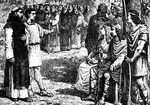
Augustine and Ethelbert
"Ethelbert met Augustine in the open air, under a tree at Canterbury, and heard him tell about the true…

Battle of Azincourt
The Battle of Agincourt was an English victory against a larger French army in the Hundred Years' War.…
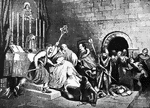
Death of Becket
"Death of Becket. During the early years of the reign Thomas A. Becket, as the king's chancellor, had…

Thomas A-Becket
The Archbishop of Canterbury, Thomas A. Becket, did not think it was right to consent to a law that…
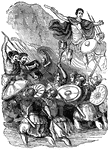
Caesar in England
"All histories of England commence with the invasion of Julius Caesar, the earliest event in that quarter…

Canute and followers
"Among the Danish kings of England, Canute stands preeminent for his wisdom and military prowess. His…
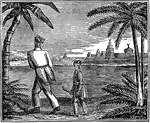
Escape of Captain Wilson
The remarkable escape and sufferings of Captain Wilson. Captain James Wilson was the first to bring…
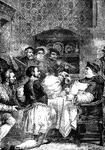
Cardinal Wolsey Served by Noblemen
When Henry VIII became king in 1509, Wolsey's affairs prospered. He became Canon of Windsor, Berkshire…
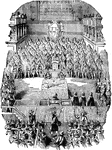
Charles I Trial
This illustration shows the trial of King Charles I. He was put on trial after a civil war, which lead…
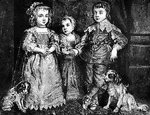
Death of Charles I
The King's trial (on charges of high treason and "other high crimes") began on January 2, but Charles…

Escape of Charles II
"That prince escaped from the battle of Worcester as soon as he saw that the day was lost. With a small…
!["The viciously inclined considered that the parliamentary order to destroy all 'monuments of idolatry' gave them liberty and license for every kind of sacrilege; so that it became a common pastime to break the painted windows and deface any statuary which adorned and beautified [England's] churches. The old market crosses which had been a notable feature of English tows, reminding the passers by of the great act of Redemption, were all ruthlessly destroyed."](https://etc.usf.edu/clipart/55500/55569/55569_cheapside_mth.gif)
Destruction of Cheapside Cross
"The viciously inclined considered that the parliamentary order to destroy all 'monuments of idolatry'…

Fairfax Taking Possession of Cochester
In 1189, Colchester was granted its first Royal Charter by King Richard I (Richard the Lionheart.) In…
Crystal Palace at Sydenham
"But perhaps the most effective and suitable employment of iron is shown in connection with glass, as…
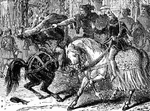
Death of Wat Tyler
Wat Tyler, while talking to the King, grew violent, forgot to whom he was speaking, and laid his hand…
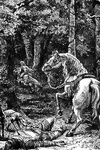
Death of William Rufus
The death of William Rufus, the third son of William the Conqueror and King of England from 1087 until…
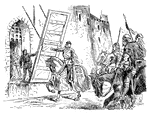
Edward II repulsed from Stirling castle by De Mowdray.
Edward II repulsed from Stirling castle by De Mowdray.
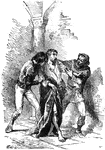
Edward II. And His Jailers
King Edward II was sent to prison for neglecting his Queen and fooling around with other men.

Execution of King Charles
When Charles was beheaded on January 30, 1649, Phillip Henry records that a moan was heard from the…
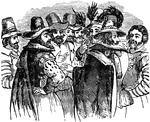
Guy Fawkes and his associates
"One of the most extraordinary events in the history of England is that commonly known by the name of…
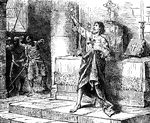
Henry III of Winchester
Henry III is one of the least-known British monarchs, considering the great length of his reign. He…
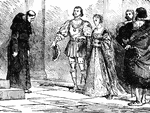
Henry the VIII and His Wives
Henry VIII was married six times during his life. First, to Catherine of Aragon, Anne Boleyn, Jane Seymor,…

Henry VIII in Council
Henry VIII in Council, an engraving print from Chronicles of England by Raphael Holinshed in 1577.

Murder of King Edmund
In the year 869, the Danes who had wintered at York, marched through Mercia into East Anglia and took…

King Henry and His Barons
King Henry was a builder of beautiful churches. Westminster Abbey, as it is now, was one. And he was…
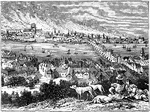
Great Fire of London
The Great Fire of London, a major conflagration that swept through the central parts of London from…
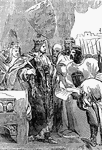
King John signing the Magna Carta
"A general joy spread through the kingdom on the publication of the Great Charter." — Goodrich,…
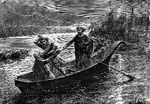
Murder of Prince Arthur
As a kind of joke, John, King Henry's youngest son, had been called Lackland, because he had nothing…
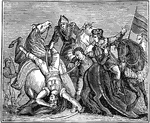
Wat Tyler's Rebellion
Wat Tyler's Rebellion was the leader of the Revolt know as the English Peasant Revolt of 1381.

Richard Removing the Archduke's Banner
During one of King Richard the Lion-Heart's crusades the city of Acre was taken over and a prince, Leopold,…

A Section of Hadrian's Wall in Britain
A small portion of the great, Roman-built Hadrian's Wall in Britain, begun in AD 122. Two men, one sitting…
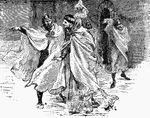
Stephen
Stephen, who was a kind-hearted man himself, tried to stop these cruelties; but then the barons turned…
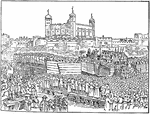
Execution of the Earl of Strafford
King Charles I signed a death warrant against Thomas Wentworth, the Earl of Strafford, after Parliament…

The Siege of Château Gaillard, the Saucy Castle of Richard the Lionheart - Aerial View
An aerial view of the siege of Château Gaillard, also called the Saucy Castle. Construction of the…
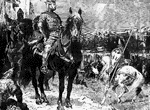
William the Conqueror
When William was denied the throne of Normandy he assembled a Norman invasion fleet of around 600 ships…

William of Normandy and His Norman Forces Land on England's Shores
Norman ships and warriors following William the Conqueror, also called William of Normandy, land on…

